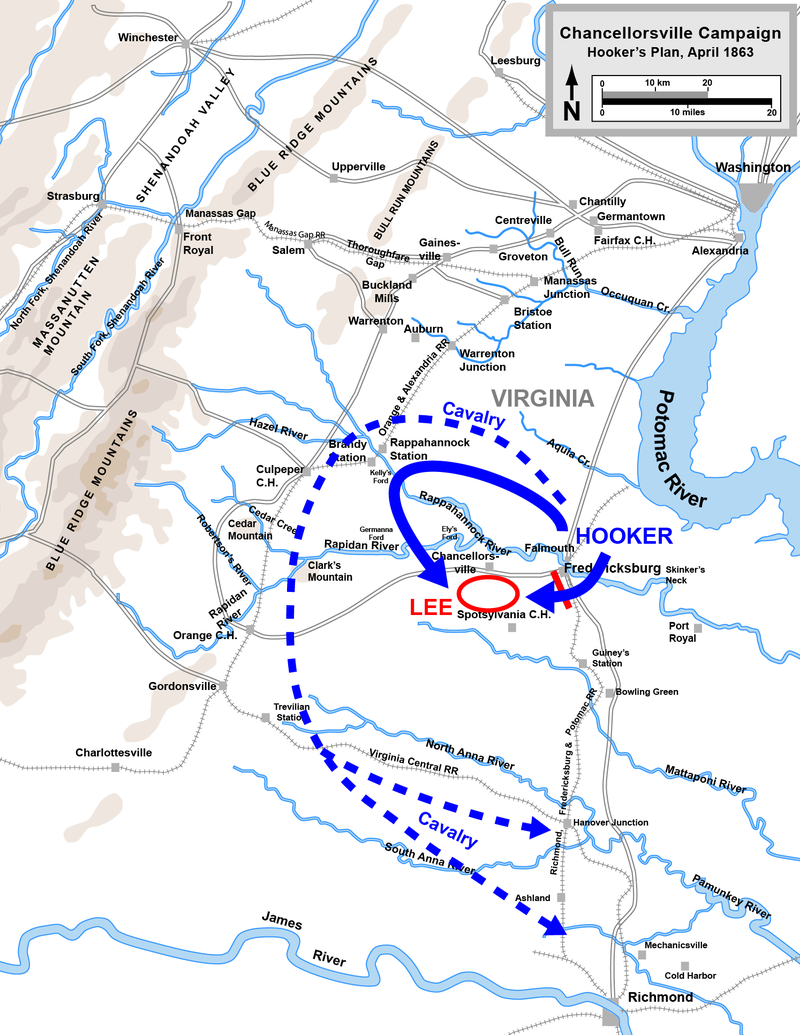The Background of Battle of Chancellorsville
Background of Battle of Chancellorsville – After the Union disaster at Fredericksburg, President Lincoln replaced Ambrose Burnside as commander of the Army of the Potomac with “Fighting Joe” Hooker. Hooker had a reputation as a hard-drinker. Charles Adams, a Union cavalry officer (and Henry Adams’s son), remarked that Hooker’s headquarters was “a place to which no self-respecting man liked to go, and no decent woman could go. It was a combination barroom and brothel.”20 Like many men who spend their time in barrooms and brothels, Hooker was a braggart. He let it be known: “My plans are perfect, and when I start to carry them out, may God have mercy on General Lee, for I shall have none.”
The Battle of Chancellorsville:
Hooker’s plan was to advance on Fredericksburg, then divide his massive army of 134,000 men, and trap Lee’s much smaller force (60,000) between his two wings (both of which would outnumber Lee), crunching the Confederates in a Union vise. It didn’t work out that way.
The Federals’ maneuver worked well enough initially—it was the Confederate response that was stunning. Lee left a small holding force of 10,000 men at Fredericksburg to hold off about 23,000 Federals. But then, to Hooker’s amazement, the Confederates, far from panicked at the 73,000 Federals forming up behind them, attacked, and drove the bluecoats back. Hooker called for reinforcements and ordered his men to dig entrenchments.
But Hooker was in for another nasty shock. Lee kept a mere 17,000 men to occupy the attention of the dug-in Federals who outnumbered him more than four to one. Meanwhile he sent Stonewall Jackson, with another 26,000 men, on a bold flanking movement against the Union right.
While Hooker imagined he had Lee trapped, it was Hooker who fingered his collar and decided to skedaddle when Jackson’s troopers came roaring into the Federal lines. The Confederates forced both sides of Hooker’s pincer movement back across the Rappahannock River, in a humiliation of the boastful Union commander.
One Union officer confessed: “They have beaten us fairly; beaten us all to pieces; beaten us so easily.” In New York, in the newspaper offices of Horace Greeley, the reaction was worse: “My God, it is horrible—horrible! And to think of it—130,000 magnificent soldiers so cut to pieces by less than 60,000 half-starved ragamuffins!” Worse still was the reaction in Washington. Senator Charles Sumner of Massachusetts exclaimed, “Lost—lost. All is lost!” Lincoln moaned: “My God! My God! What will the country say?”
What You Need to Know:
Battle of Chancellorsville was the greatest Confederate victory of the war, won against the longest odds, but for which the Confederacy paid an enormous price in the death of Stonewall Jackson, Lee’s most trusted and effective lieutenant. In the gloomy dusk, scouting ahead of his lines to see how he could capitalize on his smashing success, Jackson and his staff officers were shot by Confederate troopers who mistook them for a Federal patrol.
The Battle of Chancellorsville is considered Robert E. Lee’s masterpiece. His reputation as a military genius was sealed by fighting an incredibly successful offensive battle despite being outnumbered 2-to-1 and launching attacks on multiple fronts.
After another humiliating Union defeat at Fredericksburg, On January 26, Lincoln replaced Gen. Ambrose Burnside with Joseph “Fighting Joe” Hooker as the new commander of the Army of the Potomac, with 120,000 troops. Hooker’s plan was to send his cavalry on a raid behind Lee to cut off Lee’s communication with Richmond. He would leave 40,000 troops in front of Lee near Fredericksburg, and Hooker himself would march up the Rappahannock River and try to go around Lee’s left. If he didn’t defeat Lee at that time, he would at least force Lee to retreat. But Lee managed to achieve victory despite splitting up his forces into vastly inferior numbers and fighting the Union on multiple fronts. The outcome was 17,000 Federal casualties to 13,000 Confederates.
Scroll down to the bottom of this post to see more maps related to this battle.
Excursus – Civil War Medicine and Disease
- Effect of Minie Balls on bodies and limbs
- Lack of Anesthesia
- Amputations
- Lack of Antiseptics or knowledge of germs and infections
- Disease in camps (2 soldiers died of disease for every 1 that died of wounds).
Chancellorsville
- Hooker takes charge
-
-
- Background on Hooker (loved drink and woman, convivial, hard fighter).
- Hooker was an excellent organizer. He whipped the army into shape and raised morale. He said he had the best army on the planet.
- He also said that it wasn’t a question of whether he would capture Richmond. It was a question of when. He said he hoped God would have mercy on Robert E. Lee, because he would not have any mercy on him.
- Regarding Hooker’s bluster, Lincoln said “The hen is the wisest of all of God’s creatures, because she never cackles until the egg is laid.”
- Lincoln told Hooker that Lee’s army, not Richmond, was his target.
-
- Hooker’s Plan
-
-
- Hooker had a total of 120,000 troops, while Lee only had 60,000 (some of Lee’s army wasn’t even there…they were off looking for food).
- He would send his cavalry on a raid behind Lee to cut off Lee’s communication with Richmond.
- He would leave 40,000 troops in front of Lee near Fredericksburg.
- Hooker himself would march up the Rappahannock River and try to go around Lee’s left. If he didn’t defeat Lee at that time, he would at least force Lee to retreat.
-
- The Battle Begins
-
-
- Hooker succeeded in getting his 70,000 men around Lee’s left, arriving at an old inn called Battle of Chancellorsville. Lee now had Federal troops in front of him and others behind him.
- Hooker thought Lee would retreat, exposing his army to attack, or he would have to turn to fight Lee (neither would be good for Lee). Lee did neither.
- Lee instead split his army. He left 10,000 troops under Jubal Early near Fredericksburg to watch the Federals there.
- Lee deployed the rest of his army to an area called The Wilderness. There Union artillery would be useless and their numerical superiority would not help.
- On May 1, Hooker ordered the army to march a few miles east to get out of the Wilderness. There they ran into Stonewall Jackson’s corps.
- Hooker immediately ordered his force to retreat back to Chancellorsville. This was a huge mistake. Hooker had lost his nerve. He later said “To tell the truth, I just lost confidence in Joe Hooker.”
-
- May 2
-
-
- Lee decided to again split his army. He sent Jackson around Hooker’s right.
- With only about 14,000 men, Lee held Hooker’s attention, while Jackson took 28,000 around the Federal right and attacked.
- Jackson’s attack pushed the Federals back.
- Jackson rode forward to determine how to best continue the attack. It was dark, and Jackson accidentally rode into the line of fire of a Confederate regiment (who were firing at the enemy). Jackson was critically wounded.
- When Jackson went down, the Confederate attack lost its steam.
- Jackson’s left arm had to be amputated. When Lee learned about this, he said “He has lost his left arm, but I have lost my right.”
-
- May 3 and afterward
-
-
- On the morning of May 3, the two Confederate wings reunited. Hooker did little to stop this.
- Hooker abandoned a hilltop, allowing Confederate artillery to fire down on his troops, and he refused to send reinforcements when they were needed.
- While Hooker watched the fighting from the Chancellor house, a Confederate shell split the pillar that he was leaning against him and knocked him senseless. He remained groggy all day, but he would not relinquish command to a subordinate.
- The Union commander (John Sedgwick) in front of Fredericksburg had pushed the Confederates out of Fredericksburg and was marching toward Chancellorsville.
- Lee again divided his army, leaving 25,000 men to hold Hooker near Chancellorsville and took the rest east to deal with Sedgewick.
- On May 3-4, Lee defeated Sedgwick. (Salem Church)
- On the 6th, the Federals retreated back across the river.
-
Outcome of Battle of Chancellorsville
-
- 17,000 Federal casualties, 13,000 Confederates (including Jackson). Jackson fell ill with pneumonia. Right before he died (on the 10th), he said “Let us cross over the river and rest under the shade of the trees.”
- This battle is considered Lee’s masterpiece. Lee’s reputation as a military genius was sealed. Lee seemed unbeatable.
- However, Lee lost 23% of his army. 13 brigade commanders were killed or wounded.
- Again, the northern public was devastated.
- Lincoln: “My God, my God, what will the country say?”
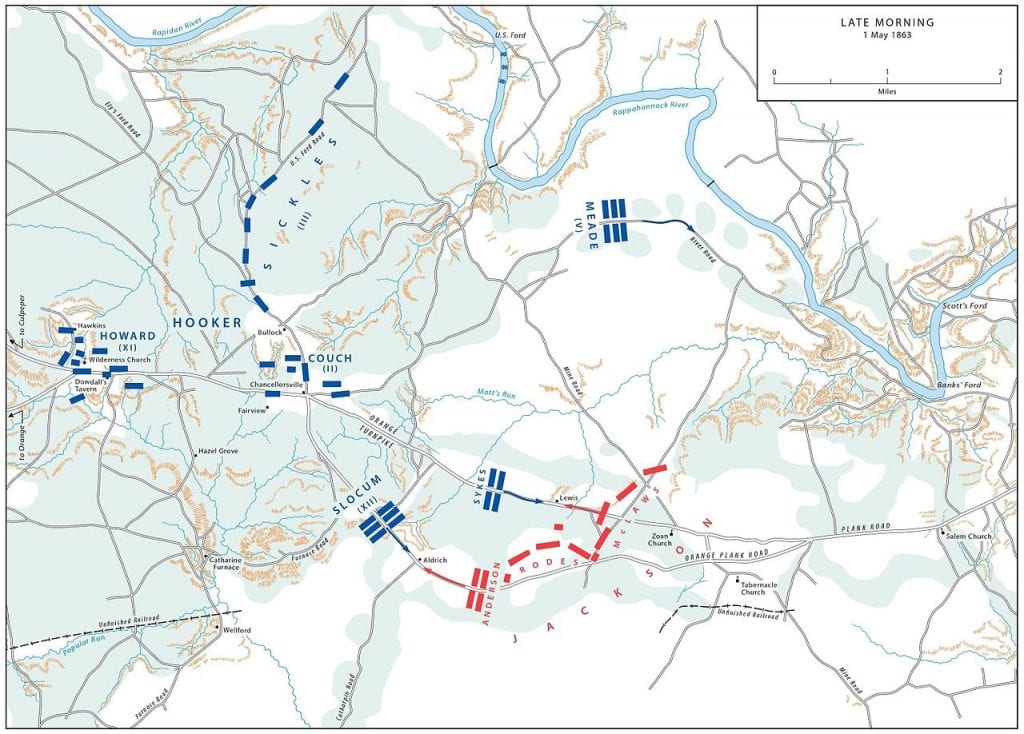
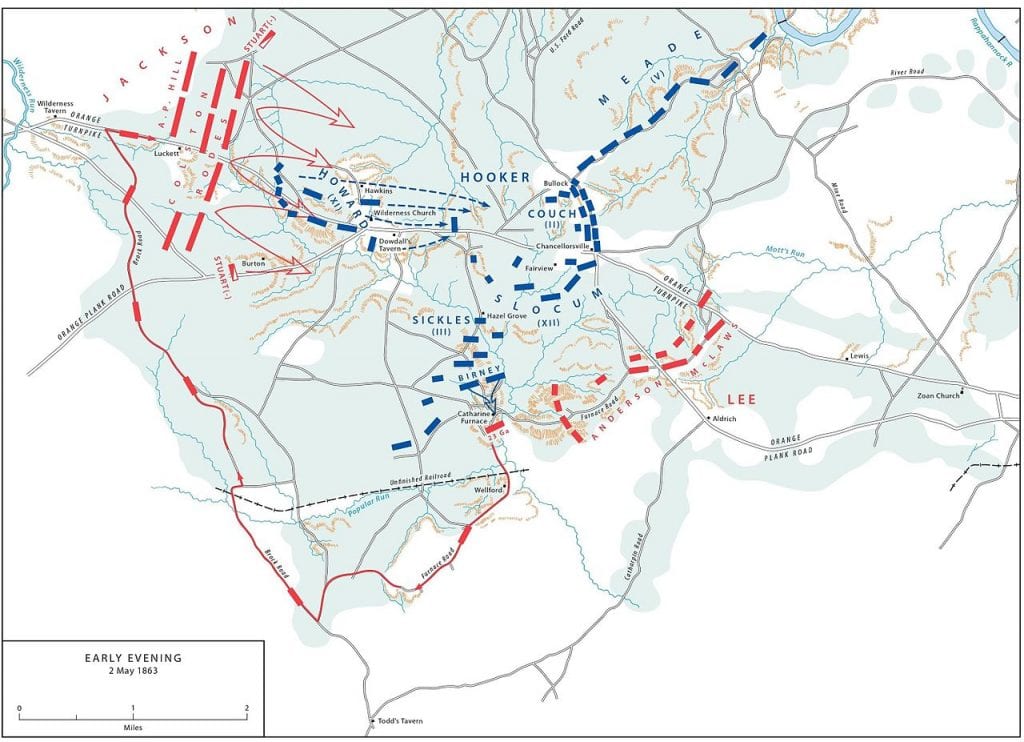
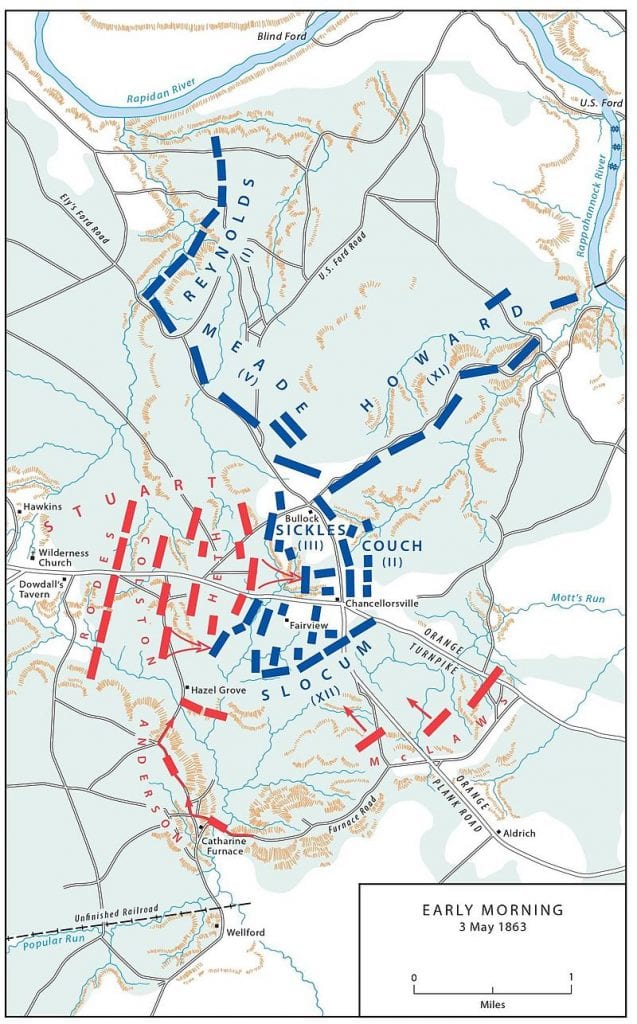
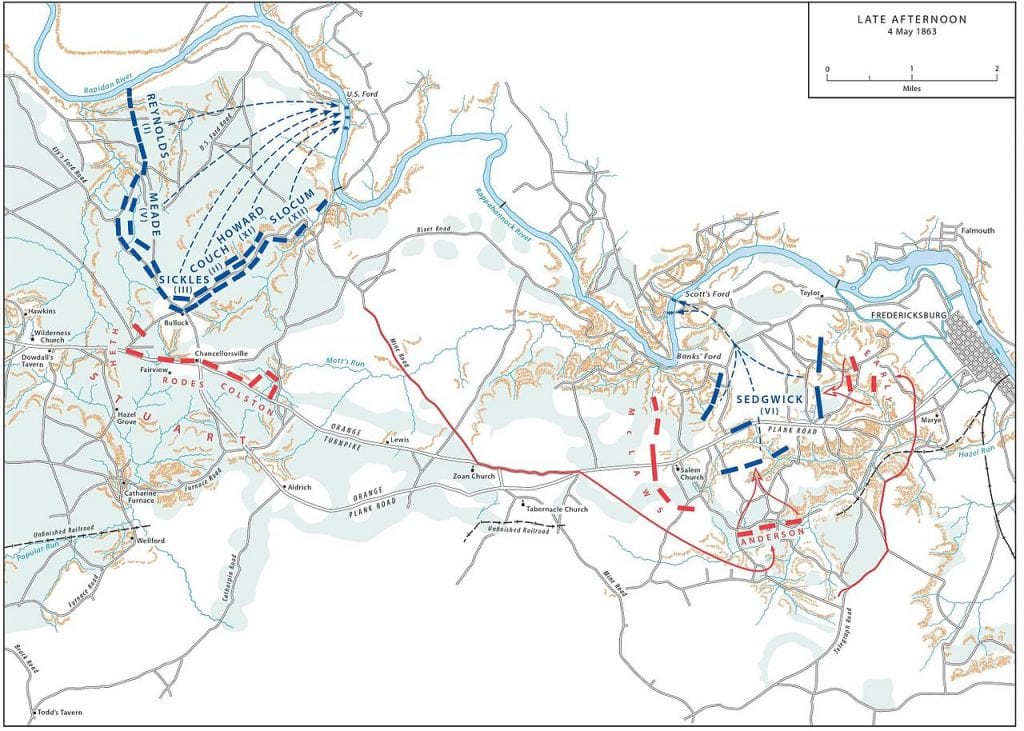
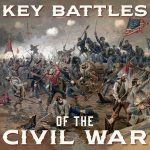 Would you like to learn the complete history of the Civil War? Click here for our podcast series Key Battles of the Civil War
Would you like to learn the complete history of the Civil War? Click here for our podcast series Key Battles of the Civil War
Cite This Article
"Battle of Chancellorsville (May 1-3, 1863)" History on the Net© 2000-2024, Salem Media.
April 25, 2024 <https://www.historyonthenet.com/battle-of-chancellorsville-civil-war-1863>
More Citation Information.



